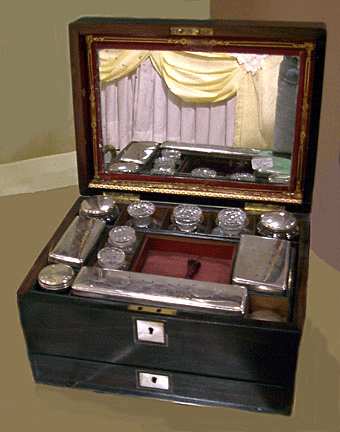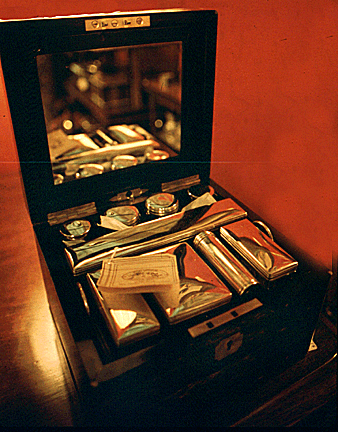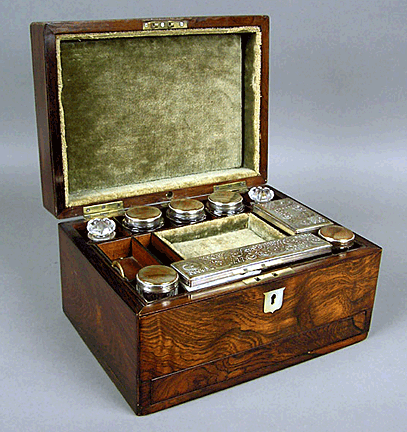|
| |
DRESSING
BOXES TO GO
by Bob Brooke
 Victorians loved fitted
boxes. And those made to hold cosmetic and toiletry implements and
supplies were no exception. However, the needs which brought these
unique boxes into being had mostly existed and had been met in some way
long before Queen Victoria’s 64-year reign commenced. As with most
antique boxes, fitted toiletry cases were made for very specific
purposes and contents. These compendia were designed to carry everything
a late 18th- or early 19th-century English woman of style and means
would need in her travels. Victorians loved fitted
boxes. And those made to hold cosmetic and toiletry implements and
supplies were no exception. However, the needs which brought these
unique boxes into being had mostly existed and had been met in some way
long before Queen Victoria’s 64-year reign commenced. As with most
antique boxes, fitted toiletry cases were made for very specific
purposes and contents. These compendia were designed to carry everything
a late 18th- or early 19th-century English woman of style and means
would need in her travels.
From the outside they look like the traveling writing boxes popular
during the 18th and 19th centuries. Sometimes a writing box was combined
with a toiletry box into a compendium, which contained fittings and
special compartments for each use, since Victorians liked to combine
numerous small cases of necessities into larger ones to lower costs.
From the middle to the end of the 19th century, they even tried for a
degree of mechanization, making them available at a lower cost using
cheaper materials to a greater proportion of the population.
But the finer boxes of this type were bought and used by the rich.
Invariably, the English toiletry box had an expensive fitted interior,
often set in tiers with pull-out drawers and many compartments. The top,
removable, tier often contained cut-glass toilet jars and bottles with
engraved silver mounts and covers. There were also separate holders and
layers to hold the toilet accessories, such as scissors, steel
nail-files, buttonhooks and penknives.
The inside of the cover may have had a framed mirror, and the base was
often fitted with a type of secret drawer released by a spring catch or
button on the top of the box inside. Few people could have been deceived
by this, however, since it was really meant to prevent the drawer from
opening while the box, itself, was closed. An alternative to the brass
button or catch was the use of a chained brass pin which slid into a
retaining hole for the secret drawer.
Some of the finest fitted English toiletry boxes and cases were made
from 1820 to 1880, though some were made as early as the late 18th
century. Most were about 12 inches wide and 10 inches deep. The height
varied, as some had multiple drawers that made them look like miniature
chests.
 Fitted toiletry boxes, also known as dressing boxes, frequently featured
a jewelry section, sometimes contained in a tray or drawer. They might
also have incorporated a writing box, a needlework section, holding
manicure and sewing implements, and a occasionally a compartment to hold
basic tea-making equipment. Fitted toiletry boxes, also known as dressing boxes, frequently featured
a jewelry section, sometimes contained in a tray or drawer. They might
also have incorporated a writing box, a needlework section, holding
manicure and sewing implements, and a occasionally a compartment to hold
basic tea-making equipment.
These dressing cases were ingeniously designed and often included much
more than the normal dressing-table set of hand-mirror, brushes, combs
and various silver-topped, cut-glass bottles and pots. In addition to a
well for holding brushes and combs, cases often contained two
spring-controlled secret drawers, one opening out of the left-hand side,
and the other, velvet-lined and fitted for jewelry, opening in the
front. A case of this type was awarded a gold medal in the 1851 London
Exhibition. This basic design was very popular and many cases of similar
layout, plain veneered but with plated fittings, were made in the 1850s.
A mother-of-pearl or brass plaque in the center of the lid was usually
engraved with the initials of the owner.
Gentlemen’s toiletry needs were well-catered for, also, but these cases
were usually smaller, because it was the custom for a pair of
hair-brushes with comb to have a leather case of their own.
A simply designed wooden, often mahogany, hollowed-out cylinder, known
as a multum in parvo, for traveling originated between 1820 and
1830 and continued in production throughout Victorian times. This was a
neat and cleverly designed wooden case that held a surprising amount of
things. A mirror in the lid concealed a well, the tray, held two razors
with a recess below them for scissors. Under the tray were compartments
for a shaving brush, tooth and ear-picks, tweezers, corkscrew and
toothbrush. At the end was circular pewter box for tooth powder. Other
popular combinations were oak veneer with carved ivory lined in blue
velvet. However, the earliest men’s cases were predominantly mahogany
with brass fittings.
More masculine and durable boxes were made for men in the military
beginning in about 1810. These often were simpler in design with little
or no decoration. Multiple layers held items for personal care as well
as eating implements of silver, ivory and ebony.
Polished veneers of strongly-colored and figured hardwoods such as
calamander, rosewood, burl walnut, satinwood and mahogany, were used for
the outside of the boxes, sometimes handsomely inlaid with contrasting
wood or mother-of-pearl, or abalone. Often the same exotic woods were
used to make writing boxes and usually they were made by the same
manufacturers. Brass inlay and ormolu mounts, which might act as
settings for semi-precious stones, were added as decoration much as they
were used in Regency furniture, and, indeed, many of toiletry boxes date
from that period. Many of these receptacles originally had outer cases
of leather or cloth for protection while traveling, an explanation of
the fine condition of those that have survived to the present day.
 Some fitted cases were made entirely of leather or shagreen, others,
essentially for use at home rather than for travel, were made of silver,
enamel, lacquer, and papier mache. Weight was unimportant, for not only
did servants travel with their masters and mistresses on coaches and
trains, but there were plenty of porters waiting to pick up a three
pence or sixpence, or perhaps even a shilling, at railway
stations. Some fitted cases were made entirely of leather or shagreen, others,
essentially for use at home rather than for travel, were made of silver,
enamel, lacquer, and papier mache. Weight was unimportant, for not only
did servants travel with their masters and mistresses on coaches and
trains, but there were plenty of porters waiting to pick up a three
pence or sixpence, or perhaps even a shilling, at railway
stations.
The interiors of these boxes were lined with satins or velvet and most
can still serve today, as useful, if somewhat bulky, dressing-table
boxes.
A dressing case shown by Asprey’s of London at the 1862 London
Exhibition was of polished walnut with gilt-engraved corners and locks,
escutcheons and handles. The silver-gilt and cut-glass interior fittings
included all the usual toilet requisites--a tray of manicure- and sewing
implements, a magnifying glass, a stationary drawer, a blotter and a
pair of candlesticks. Such a case, ideal for traveling, would originally
have had a protective case of leather.
Less luxurious, but nevertheless a high-class piece, would have been the
dressing case with an exterior veneered in calamander wood, inlaid with
brass and mother of pearl. The interior might have been lined with
gold-tooled cerise leather, matching stain an crushed velvet. The
fittings in the upper tray would have been of engraved silver and cut
glass with matching silver lids. A velvet-cushioned panel held in the
lid by a spring would have been reversible, the other side containing a
dressing mirror. This removable panel would have formed the lid of a
recess to hold papers.
The typical English box was made of walnut bound in brass and bore a
hallmark on its underside, which is useful in dating it. Well made and
fitted, their high prices at auction sales and dealers shops don’t
really equate with the original maker’s price in the 19th century. While
toiletry boxes can be found today selling for as little as $2,000, their
overall condition and number of accessories still in them help to define
their price. A fine toiletry box of satinwood cross-banded with kingwood
with crystal and silver containers, dating 1869, for example, sells
today for $5,500. One of a similar size in calamander wood with brass
edges and its original leather case, sells for $7,400. And still another
of rosewood and brass sells for $7,500.
Yet, this again is a result of the change of social habits. After all, a
plastic make-up box is much easier to carry, much lighter and a whole
lot less expensive--if all that’s desired is pure function. But for
shear luxury, nothing can beat a fine old English dressing box.< Back to
Antiques Articles
Go to the next antiques article
> |
|
